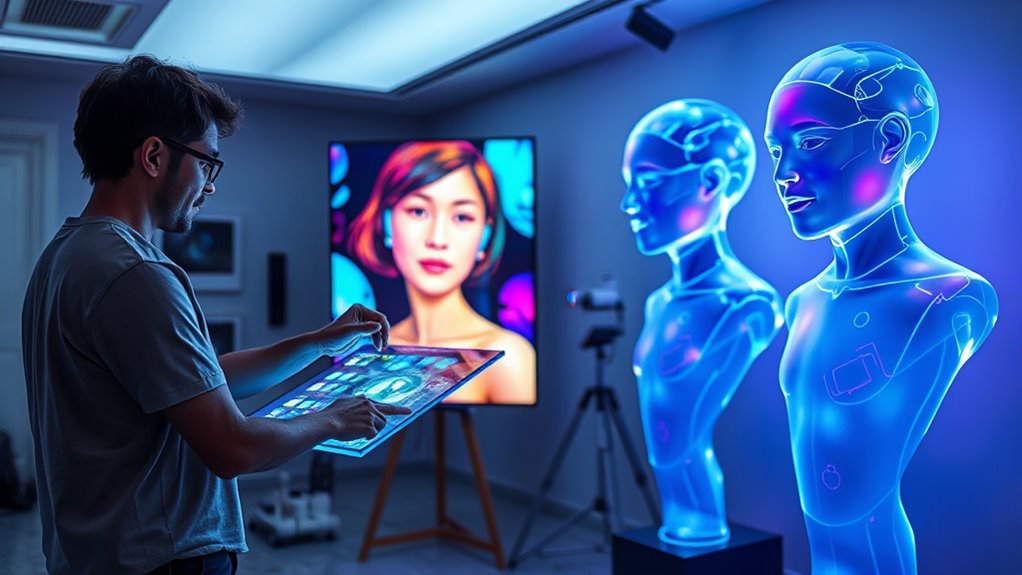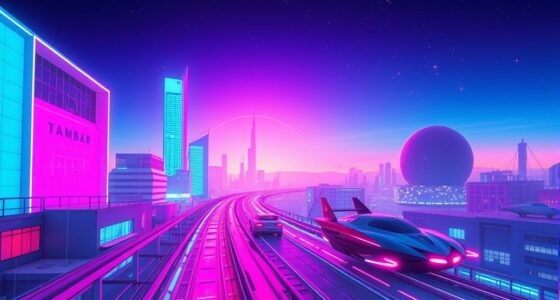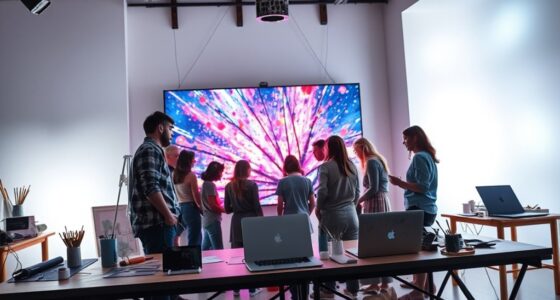The rise of AI alter egos lets artists create convincing digital twins and virtual personas that expand creative limits and audience reach. These AI-driven characters let you experiment with identity, style, and storytelling in immersive ways. While they open new artistic possibilities, they also raise ethical concerns about authenticity, ownership, and manipulation. If you explore further, you’ll discover how these digital innovations are shaping the future of art and personal expression.
Key Takeaways
- AI enables artists to create digital twins that mirror their personalities, styles, and creative processes, expanding artistic possibilities.
- Digital alter egos facilitate global reach, audience engagement, and continuous reinvention beyond physical and traditional constraints.
- Ethical concerns arise around consent, authenticity, ownership, and potential misuse of AI-generated digital personas.
- Notable artists like Ai-Da and Refik Anadol exemplify integrating AI personas into immersive art experiences.
- Future trends include immersive virtual environments, blockchain ownership, and AI as a collaborative creative partner.
The Evolution of Artistic Personas in the Digital Age

The digital age has transformed how artists craft and present their personas, allowing them to experiment with multiple identities and reach global audiences instantly. You can now create a digital footprint that showcases diverse facets of your creativity without physical boundaries. Social media platforms enable real-time interaction, making it easier to build a dedicated following. You no longer need traditional gatekeepers like record labels or galleries; instead, you can publish, promote, and refine your persona directly. This shift empowers you to reinvent yourself repeatedly, blending personal expression with strategic branding. As a result, artistic personas are no longer static; they evolve dynamically, shaped by digital tools and instant feedback. The use of digital projection technology further enhances the possibilities for artists to present immersive, interactive personas that captivate audiences. This evolution makes your creative journey more flexible, accessible, and interconnected than ever before.
How AI Creates Virtual Artists and Characters

AI develops virtual artists and characters by analyzing vast amounts of data to craft believable digital personas. As you explore this process, it’s important to contemplate the ethical questions surrounding their creation and use. These considerations shape how we accept and integrate virtual entities into the artistic landscape. Furthermore, techniques like ECU tuning are employed in vehicle customization, demonstrating how data-driven modifications can significantly alter performance and perception.
Digital Persona Development
Digital persona development involves crafting virtual artists and characters that can interact convincingly with audiences. You start by defining their personality, style, and backstory, ensuring these elements resonate with your target viewers. Using AI algorithms, you generate realistic facial features, voices, and mannerisms, making your digital persona feel authentic. You also incorporate machine learning to enable the character to adapt and respond dynamically during interactions. This process involves training models on vast datasets, from art styles to speech patterns, to refine the character’s behavior and appearance. By continuously tweaking these elements, you create a virtual artist capable of engaging audiences in real-time, establishing a unique digital identity that feels both immersive and authentic, all while maintaining control over the persona’s evolution. Incorporating visual authenticity through detailed design and realistic rendering further enhances the believability of the digital twin.
Ethical Considerations
As virtual artists and characters become more sophisticated, ethical questions arise about their creation and use. You need to take into account issues like consent, authorship, and potential misuse. Who owns the rights to a digital twin? Can these entities be exploited or manipulated? Transparency about AI-generated content is essential to prevent deception. You should also reflect on the impact on human artists and cultural diversity. To clarify these concerns, consider this table:
| Ethical Issue | Key Concern |
|---|---|
| Consent | Was the digital twin created with permission? |
| Authenticity and Deception | Does viewers know it’s AI-generated? |
| Exploitation | Could AI be used to manipulate or harm? |
Addressing these questions ensures responsible innovation and respects ethical boundaries in AI art. Additionally, ongoing debates about cultural diversity highlight the importance of maintaining a wide range of artistic expressions in the digital era.
The Technology Behind Digital Twins in Art

Behind the creation of digital twins in art lies a sophisticated blend of technologies that work together to replicate an artist’s style and presence. Machine learning algorithms analyze vast amounts of the artist’s work, identifying patterns, brushstrokes, and color choices. These data sets train neural networks to mimic the artist’s unique techniques. Natural language processing helps generate authentic dialogue or narration that reflects the artist’s voice. 3D modeling and rendering tools create virtual environments or sculptures, giving the digital twin a tangible presence. Additionally, real-time data integration allows the twin to respond dynamically to viewer interactions. Moreover, understanding different brewing techniques can inspire artists to incorporate diverse styles and textures into their digital creations. Combined, these technologies enable digital twins to authentically emulate an artist’s creative essence, making their digital persona compelling and immersive.
Benefits and Challenges of AI-Driven Alter Egos

AI-driven alter egos can greatly expand your creative freedom, letting you explore new artistic territories. However, they also raise questions about authenticity and identity that you’ll need to contemplate carefully. Plus, ethical concerns around ownership, representation, and potential misuse are challenges you’ll want to navigate thoughtfully. Incorporating tools like eye patches as part of your aesthetic or self-care routine demonstrates how physical enhancements can complement digital identities, adding another layer to the ongoing conversation about authenticity.
Creative Freedom Expansion
How does the use of AI alter egos expand creative freedom for artists? AI allows you to experiment with new styles, genres, and personas without the constraints of physical limitations or traditional resources. You can generate unique visuals, sounds, or narratives instantly, pushing boundaries you might not have dared before. This technology frees you from technical hurdles, enabling rapid iteration and exploration of ideas. You’re no longer confined by your skill level or available tools—AI acts as a collaborative partner, amplifying your imagination. Moreover, understanding the boundaries of originality is essential to navigate ethical questions about ownership and the authenticity of AI-generated content. Still, AI-driven alter egos open exciting possibilities, empowering you to redefine what’s creatively possible.
Authenticity and Identity
Using AI to create alter egos raises important questions about authenticity and identity, as artists must consider how their digital personas reflect their true selves. These AI-driven alter egos can amplify your creative expression, letting you explore new styles or themes without risking your personal reputation. However, it also challenges the notion of genuine connection, since audiences might struggle to distinguish between the artist’s real identity and their digital twin. You may find that your alter ego becomes a separate entity, sometimes overshadowing your authentic self. This duality can lead to confusion about who you truly are and what you stand for. Balancing the benefits of innovation with the need for genuine self-representation becomes essential in this evolving digital landscape. Additionally, understanding the concept of identity and how it is shaped in digital environments is crucial for navigating this new artistic frontier.
Ethical Considerations
Creating digital alter egos offers significant benefits, such as expanding creative possibilities and engaging audiences in new ways. However, ethical considerations also come into play. You must consider issues like consent, especially when replicating a person’s likeness or voice. There’s a risk of misuse, such as deepfakes or unauthorized representations, which can damage reputations or manipulate perceptions. Transparency is vital—audiences should know when they’re interacting with AI-generated content. Additionally, the potential for bias or misrepresentation raises questions about fairness and accountability. As an artist or creator, you need to weigh these challenges carefully. Balancing innovation with ethical responsibility ensures that AI alter egos enhance creativity without infringing on rights or spreading misinformation. Moreover, understanding the different cookie categories employed by platforms can help manage user data privacy and consent effectively.
Case Studies: Notable Artists Using AI Personas

Several renowned artists have embraced AI personas to push the boundaries of their creative work, blurring the lines between human and digital expression. These artists leverage AI to explore new storytelling methods and challenge traditional notions of authorship. For example:
- The artist known as Ai-Da uses an AI-powered robot to create and perform artwork, blending robotics with visual art.
- Hito Steyerl employs AI-generated visuals to critique digital culture and social issues through immersive installations.
- Refik Anadol transforms vast datasets into mesmerizing digital environments, creating immersive experiences that redefine visual art.
- Many artists incorporate digital support solutions like AI to enhance comfort and creative expression, expanding the possibilities of their art forms.
Ethical Considerations and Authenticity in Digital Art

As digital art becomes more prevalent through AI-generated works and digital twins, questions about ethics and authenticity come to the forefront. You might wonder if AI-created pieces truly reflect the artist’s vision or if they’re just clever simulations. It’s essential to contemplate transparency—are artists clear about using AI, or is it hidden behind the scenes? This raises concerns about originality and deception. You should also reflect on consent; when digital twins mimic living artists, are their rights respected? Additionally, the potential for misuse, like deepfakes or misrepresentation, poses ethical risks. Ultimately, you need to balance innovation with responsibility, ensuring that digital art remains honest, respectful, and true to its creative roots.
Future Trends: The Next Frontier for AI and Artistic Expression

The future of AI and artistic expression promises to push boundaries further than ever before, blending human creativity with machine intelligence in innovative ways. You can expect AI to become a more active collaborator, co-creating art that challenges traditional notions of authorship. Three key trends will define this frontier:
- Personalized Artistic Experiences: AI will craft tailored content that reflects individual tastes and emotional states, fostering deeper connections.
- Immersive Virtual Realities: Artists will leverage AI to develop interactive environments, blurring the lines between physical and digital art forms.
- Decentralized Artistic Platforms: Blockchain-enabled AI tools will democratize art creation, giving creators more control and ownership over their work.
These developments will propel artistic expression into uncharted territory, transforming how you engage with and interpret art.
Frequently Asked Questions
How Do AI Alter Egos Influence Traditional Notions of Artistic Authenticity?
AI alter egos challenge your idea of artistic authenticity by blurring the lines between human creativity and machine-generated work. You might feel unsure whether these digital twins truly reflect your original vision or just mimic it. As you explore this new landscape, remember that authenticity can evolve, incorporating technology as an extension of your artistic expression. Embrace the innovation, but stay true to what makes your art meaningful to you.
What Legal Rights Do Ai-Created Personas Hold in the Art World?
Imagine a digital mirror reflecting your creative spirit—AI-created personas can hold legal rights like copyright or trademark if they’re recognized as distinct entities. You might need to register these personas or establish ownership through contracts, ensuring your digital twin’s creations are protected. But laws are evolving, so stay alert to new regulations, and consider legal advice to safeguard your AI alter ego’s rights in the art world.
Can Ai-Generated Digital Twins Truly Replace Human Artists?
AI-generated digital twins can’t truly replace human artists because they lack genuine creativity, emotional depth, and personal experiences that inspire art. While they can mimic styles and automate tasks, your unique perspective, intuition, and emotional connection bring authenticity to your work. Technology enhances your craft, but it doesn’t replicate your human touch. Ultimately, your personal story and feelings give your art its true worth and meaning.
How Do Audiences Typically Respond to Ai-Driven Art Personas?
You might find that audiences are fascinated by AI-driven art personas, often intrigued by the blend of technology and creativity. They may feel curious or even skeptical, questioning the authenticity behind the digital twin. Some embrace the innovation, appreciating the new artistic possibilities, while others prefer human-created art for its emotional depth. Overall, audience responses vary, but many are enthusiastic to explore how these AI personas enhance or challenge traditional art perceptions.
What Are the Potential Risks of Over-Relying on AI in Creative Industries?
You know what they say—don’t put all your eggs in one basket. Over-relying on AI in creative industries risks stifling originality, eroding human touch, and creating a homogenized art scene. It can also lead to job losses and diminish authentic emotional connections. If you lean too heavily on AI, you might sacrifice the unpredictable creativity that makes art compelling, ultimately risking the loss of true artistic diversity and depth.
Conclusion
As AI continues to shape artistic identities, you’ll find yourself questioning what’s real and what’s created. These digital twins push boundaries, blurring lines between authenticity and innovation. Will they redefine artistry or challenge its very essence? The future holds endless possibilities—and surprises—waiting to be uncovered. Stay tuned, because in this evolving landscape, tomorrow’s art might just be born from the minds of machines, leaving you keen to see what’s next.









